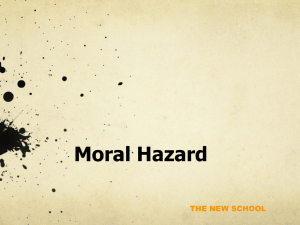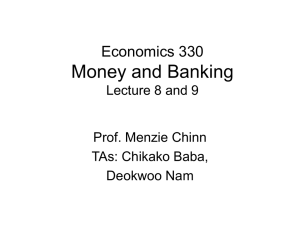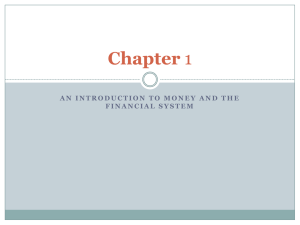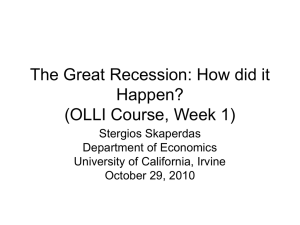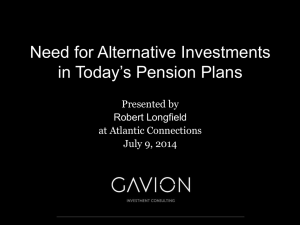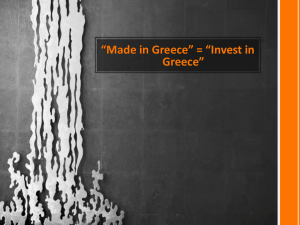Lecture Slides - European University Institute
advertisement
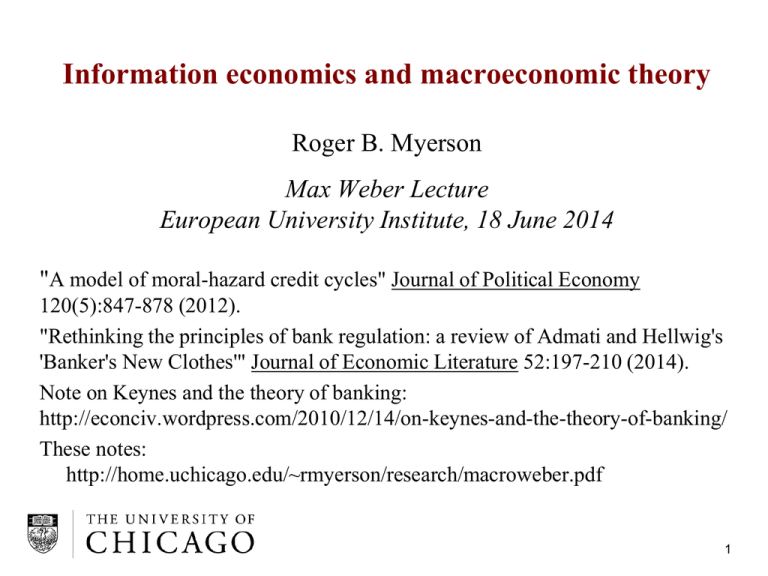
Information economics and macroeconomic theory
Roger B. Myerson
Max Weber Lecture
European University Institute, 18 June 2014
"A model of moral-hazard credit cycles" Journal of Political Economy
120(5):847-878 (2012).
"Rethinking the principles of bank regulation: a review of Admati and Hellwig's
'Banker's New Clothes'" Journal of Economic Literature 52:197-210 (2014).
Note on Keynes and the theory of banking:
http://econciv.wordpress.com/2010/12/14/on-keynes-and-the-theory-of-banking/
These notes:
http://home.uchicago.edu/~rmyerson/research/macroweber.pdf
1
Introduction
Macroeconomists have learned much since 1929, and the world is
significantly better for it.
But the financial crisis of 2008 and its aftermath have shown that
economists still need to learn more.
I will explain why I think that we should look to information economics,
particularly to moral-hazard agency theory, for much of the new
understanding that is needed.
Foundations of macroeconomic theory by Keynes, Fisher, and Friedman
long preceded the foundations of information economics in 1970s,
which depended on game theory by von Neumann and Morgenstern.
There has been some work to construct macroeconomic models with
agency theory, since Bernanke-Gertler (1989), but more is needed.
2
A General Theory without bank failures or credit rationing
Much of macroeconomic theory follows from or responds to Keynes's
General Theory of Employment, Interest and Money (1936).
But the General Theory discusses of saving and investment at length
without seriously considering financial intermediation or bank failures.
His General Theory even ignores his own observations on how monetary
policy can affect aggregate investment without changing interest rates.
"There is normally a fringe of unsatisfied borrowers to whom a bank would
be quite ready to lend if it were to find itself in a position to lend more.
The existence of this unsatisfied fringe allows the Banking System a means
of influencing the rate of investment supplementary to the mere changes
in the short-term rate of interest." Keynes, Treatise on Money, 1930.
Why did he omit this vital observation from his "General Theory"?
Such credit rationing may have seemed theoretically indefensible in 1936...
3
Credit rationing from moral hazard
Credit rationing may have seemed theoretically indefensible in 1936,
but 35 years later, Stiglitz and Weiss (1981) derived it from moral
hazard and adverse selection in finance.
When an entrepreneur borrows from a bank to finance a new venture,
the probability of its success may depend on entrepreneurial efforts
that a bank cannot directly monitor.
To motivate such hidden efforts, the borrower must anticipate
substantial profit from his venture's success (moral-hazard rents).
This need to let borrowers keep enough profit from their success can
impose an upper bound on the interest rate that banks can charge.
So interest rates might not rise even when qualified eager borrowers
cannot find funds.
4
The vital role of information economics
Problems of getting people to choose hidden actions appropriately are
called moral hazard.
Problems of getting people to share hidden information honestly are
called adverse selection.
Such problems of agents having different information are analyzed by
modern information economics, which first developed in 1970s,
building on advances in game theory.
Banks and other financial intermediaries earn profits by having better
information about investments than their depositors, so a theory of
banking depends on information economics.
"Twenty years ago, there was no microeconomic theory of banking, for
the simple reason that the general equilibrium model was unable to
explain the role of banks. Since then, a new asymmetric-information
paradigm has emerged that has been useful in explaining the role of
banks and pointing out weaknesses of the banking sector."
X. Freixas, J.-C. Rochet (1997)
5
Adverse selection can make expert investors issue debt
Entrepreneurs and industrialists have expertise about the potential
profitability of their firm and its investment opportunities.
When an investment opportunity requires outside financing, they may
choose between issuing debt or new equity shares.
Selling new equity can dilute the value of their own shares.
Given any market price at which they can sell new equity shares, they
are more likely to do so when their private information suggests
that this price may be too high.
Thus, outside investors see a firm's decision to issue new equity as bad
news about the value of the firm (winner's curse).
This inference decreases the price that outside investors are willing to
pay for equity shares.
Thus, entrepreneurs often find it better to issue debt, the value of
which is less uncertain to investors. (Myers Majluf, 1984).
...Short-term debt avoids risks of future adverse news about firm.
6
Deflation can cripple the economy's key experts
...Financial and industrial leaders with best information about investment
opportunities tend to finance investments largely by monetary debt.
When prices are lower than was expected, however, these debts become
harder to repay from the profits of real economic investments.
Deflation causes a general decrease in the real net worth of those who
know the most about investment opportunities in the economy.
When such entrepreneurs are overburdened by debt, they are less able to
make new productive investments, which can cause a recession.
Then an inflation could help reduce the real burden of entrepreneurs' debts.
So the vital role of price-level changes in Fisher's (1933) debt-deflation
theory of depressions can be derived from adverse selection in finance.
The wealth of entrepreneurs and other informed financial agents becomes a
key macro state variable in a balance-sheet theory of recessions and
monetary policy.
7
Probing the foundations of balance-sheet recession theory
The net wealth of informed financial agents becomes a key macro state variable in
a balance-sheet theory of recessions and monetary policy.
When all informed agents are poorer, investment opportunities are lost,
underemployment then can increase marginal returns to investment.
If the possibility of such an event were anticipated, the agents would prefer
to have their real debt burden reduced in such an event, as could be
achieved by inflationary monetary policy in a balance-sheet recession.
The real impact of monetary policy here depends on informed agents'
financing their investments with debt that is in monetary units.
DiTella (2013): Why don't firms borrow in a broad economic index?
Their choice to do so might be seen as evidence that they got information
suggesting that the index is likely to fall. (Winners' curse again.)
Adverse inference can make choice of debt numeraire a game of multiple
equilibria, with a focal equilibrium in money issued by the government.
8
Focusing on moral hazard in financial intermediation
Moral hazard in financial intermediation has an essential fundamental
role at the heart of any capitalist economy.
Problems of moral hazard in banking were evident at many stages of
the recent financial crisis.
A successful economy requires industrial concentrations of capital that
are vastly larger than any typical individual's wealth.
The mass of small investors must rely on specialists to do the work of
identifying good investment opportunities.
Individuals who hold such financial power may be tempted to abuse it
for their own personal profit.
Bankers and other financial intermediaries borrow much of what they
invest, but their incentives to invest well depend on their having a
stake in the profits of their investments (capital).
9
Can moral hazard in banking cause recessions?
In "Moral-hazard credit cycles," I show how macroeconomic fluctuations
can be driven by moral hazard in financial intermediation.
I assume investors can find good investments only through financial agents,
who may be tempted to divert funds to their cronies' bad investments.
Such behavior is efficiently deterred by promising big late-career rewards
for agents who consistently deliver successful investments.
The promise of one big bonus at the end can motivate good behavior
throughout an agent's career!
This need to invest through agents who have long-term career incentive
plans can create complex macroeconomic dynamics.
When there is a shortage of trusted financial agents, investment is reduced,
and employment may suffer.
But recruiting more young agents then can create a future surplus, as their
responsibilities will grow until retirement under efficient incentive plans.
So recovery is gradual and yields subsequent booms and recessions.
10
Moral hazard credit cycles: the formal model
A financial agent who is new at t can serve n periods (t,...,t+n1), retires at t+n.
An investment of size h at time t will return, at time t+1, t+1h if success, else 0, with
P(succ)= if supervised appropriately, else P(succ)= if wrongly, where > .
Acting wrongly yields hidden benefits worth h to agent at time t.
Risk-neutral agents discount future payoffs at rate per period.
(Assuming < (1/)2 implies wrongful action is not worthwhile in equilibrium.)
With agent's expected rewards v from success or w from failure at time t+1, need
[v + (1)w]/(1+) h + [v + (1)w]/(1+) (incentive constraint),
v0, w0 (limited liability).
To invest h at t, the agent's minimal expected reward (moral-hazard rent) at t+1 is
v+(1)w = hM, with v = hM/ and w=0, where M = (1+)/().
Investors supply funds elastically at rate , and expect no surplus in equilibrium.
Optimal contracts: new agent at t will get M(1+)n1/n at t+n if always succeeds,
will invest (1+)s/s at t+s if always succeeds until then, else 0.
If new agents invest Jt at each t, total investment at t is It = s{0,1,...,n1} Jts(1+)s.
Assume expected surplus at t+1 depends on investment by t+1 (1+) = R(It),
where R(.) is a decreasing investment-demand function.
Equilibrium condition for new agents to be hired at t: R(It)+...+R(It+n1) = M.
11
Investment by young bankers
Investments by 8 cohorts of middle-aged bankers
Investment by old bankers
1.2
1.1
1
0.9
0.8
0.7
0.6
0.5
0.4
0.3
0.2
0.1
0
steady
state
0
1
2
3
4
5
6
7
8 9 10 11 12 13 14 15 16 17 18 19 20 21
Time period
Investment amounts handled by different cohorts of bankers with 10-period careers,
starting at time 1 with bankers investing only 80% of steady-state amounts.
Parameters: n=10, =0.1, =0.95, =0.57, =0.12, R(I) = 0.36 0.327 I. (M = 0.33)
12
Financial regulation: who monitors the monitor?
Adverse selection creates impetus for debt financing, but moral hazard implies
that those who control a firm must have some stake in its profits (capital).
Banks monitor entrepreneurs' capital when they borrow.
To maintain depositors' trust, someone must monitor banks' capital.
America 1907: JP Morgan as monitor of last resort ...and monopolizer?
Public regulators and central banks as monitors of last resort.
Regulatory capital requirements that are based on public information can
help reduce the adverse-selection problem in selling new equity.
Central bank's lending can signal confidence in value of a bank's assets.
Basel tried to encourage safe investments by requiring less capital for
them, but capital provides the owners' basic incentive to limit risks.
Such rules created systemic risk when assets were wrongly judged safe
(mortgage-backed securities, sovereign government debt).
Public officials are also subject to moral hazard temptations, and their
democratic accountability is an essential part of the system.
Regulations which cannot be publicly monitored may not be credible.
13
Shocks of moral hazard parameters
Moral-hazard agency theory can offer a new view of macroeconomic
fluctuations driven by changes in moral hazard parameters.
In model of moral-hazard credit cycles, suppose a shock could change
moral-hazard parameters (such as , the fraction an agent can take).
Legal and political reforms or new control systems may allow small
investors to invest with less moral-hazard rents for intermediaries.
The ability to attract global investment with less agency cost can be a
vital key to economic development.
But controls for new securities might prove less effective than believed.
What if investors overestimated their deterrents against malfeasance?
Agents whose temptations are greater than their promised rewards
would quietly cheat investors, until the pattern becomes evident.
Then a sudden loss of trust in financial agents could severely reduce
investment, until financial agents could accumulate more capital.
14
Conclusion: incorporating finance into macroeconomics
Paul Krugman's view of what economists have to do:
"First, they have to face up to the inconvenient reality that financial
markets fall far short of perfection, that they are subject to
extraordinary delusions and madness of crowds.
Second, they have to admit that Keynesian economics remains the best
framework we have for making sense of recessions and depressions.
Third, they'll have to do their best to incorporate the realities of finance
into macroeconomics."
Paul Krugman, NYTimes, 6 Sept 2009
I agree strongly with Krugman's third point, that economists need to
incorporate finance into macroeconomic theory.
But we are unlikely to do this by using an old Keynesian theory that was
developed when economists had no analytical models of banking or
financial markets.
15
Conclusion: applying information economics in macro
In Keynes' day, differences among traders' information were "market
imperfections," but now economists regularly analyze problems of
trust among people with different information.
This is the subject of information economics and agency theory, and
it is essential for understanding financial problems today.
In particular, when information is costly, members of a crowd may
rationally choose to rely on the expertise of others, whose
temptation to mislead must be countered by greater long-run
rewards from maintaining a good reputation.
A collapse in the supply of such good reputations would indeed be a
crisis.
16
References
"A model of moral-hazard credit cycles" Journal of Political Economy 120(5):847878 (2012).
"Moral-hazard credit cycles with risk-averse agents" to appear in J. of Economic
Theory (2014). http://home.uchicago.edu/~rmyerson/research/rabankers.pdf
"On Keynes and the theory of banking" (2010 blog)
http://econciv.wordpress.com/2010/12/14/on-keynes-and-the-theory-of-banking/
"Rethinking the principles of bank regulation: a review of Admati and Hellwig's
'Banker's New Clothes'" Journal of Economic Literature 52:197-210 (2014).
These notes:
http://home.uchicago.edu/~rmyerson/research/macroweber.pdf
17
